Christmas Tree Calculator
Ho ho ho! Christmas is just around the corner! Every town becomes more and more colorful, and brilliant lights and beautiful ornaments decorate buildings. And finally, huge Christmas trees, probably the most recognizable sign of Christmas, arise in the big squares in the city centers. This is the perfect time to bring Christmas Trees to our homes too! Let's explore how to put up the ornaments and predict how many you will actually need. Believe it or not, the math professor has already calculated it, and our team of physicists improved it even more.
The calculator guides you step-by-step with real-time computation and visualization simultaneously. If you're unsure about it, keep reading the article below for some examples and ideas. We've also written about the history of Christmas trees — why we bring them and decorate them in our homes. In the end, you will find an answer to the age-old debate of whether ribbons are superior to lights as Christmas decorations.
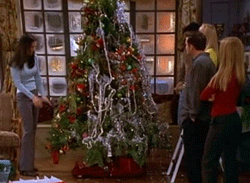
Oh Christmas tree! The ultimate Christmas decorations
Christmas is upon us, much closer than you might think, but still further than advertisements want you to believe. The real conclusion, if you look at how many days remain until Christmas, is that we should start getting ready for it. One of the things you probably want to set up is your Christmas tree. And no Christmas tree is complete without ribbons or lights. This raises an important question: How many Christmas tree lights do you need to decorate your tree properly?
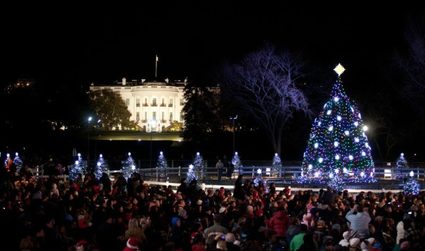
The term "properly" is subjective, but assuming you already have a perfect way that you believe the tree should look, how do you know the length of lights you will need to decorate your Christmas tree? We have the solution! In the following sections, we show you how to wrap a Christmas tree most efficiently and aesthetically. How? — you might ask — how to decorate a Christmas tree perfectly? It's easy. We just need math and a bit of ingenuity.
When deciding how to decorate a Christmas tree, there are many subjective things to consider. Whether you prefer ribbons or light, what colors to use, how bright (we measure brightness in lumen) you want it to be, how high is your electrical budget, and even where you want your tree (indoors or outdoors). However, certain aesthetic factors will please most people, such as uniformity, symmetry, and proportionality... And those are the kinds of things that we can help you with in our Christmas tree calculator.
How to use the calculator
Before we get to know how the Christmas tree calculator works, let's see how you can use it for your purposes. To begin the explanation, let us explain what each of the fields is referring to (take a look at the picture below for more details):
-
Height of the foliage: vertical distance from the tip of the tree to the end of the foliage; -
Bottom diameter of foliage: diameter of the tree — the lowest part of the foliage; -
What do you want to calculate?: you can perform calculations in two ways: select the desired option; -
Strand length: the length of the ribbon or lights to decorate the tree; -
Rotations around the tree: how many times the chosen decoration will go around the tree; -
Strand spacing: distance between one rotation of the decoration and the next one; -
Baubles density: measures how much of the tree will be covered by baubles; -
Number of baubles: the number of baubles required to achieve such tree coverage; -
Baubles diameter: the average value of your baubles; and -
Christmas tree coverage: percentage of the surface of the tree that will be covered by baubles.
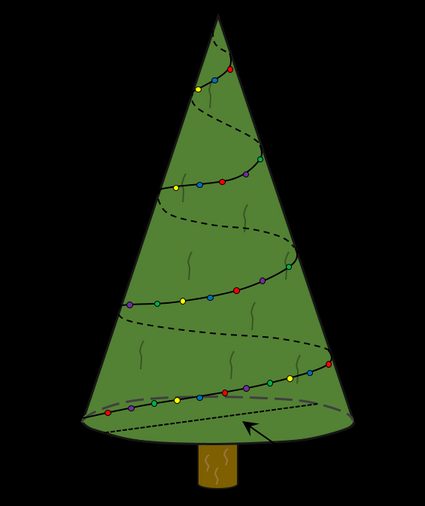
The Christmas tree calculator has 4 sections. The first section is dedicated to entering the dimensions of the tree that we want to decorate. The second and third sections are devoted to the actual Christmas decorations with 2 options: lights (or ribbons) and baubles.
For both the Christmas tree and the baubles sections, you will need to provide 2 inputs, while for the Christmas tree ribbon/lights section, you only need to provide one. In the previous section of the text, we discussed how to decorate a Christmas tree in the most effective and harmonious way, so that is how the calculator assumes you will do it.
The Christmas tree calculator will show a simulated image of how the tree would look with either the lights/ribbons or the baubles. The pictures will give you a good idea of how the Christmas tree would look using the parameters you have entered.
Christmas tree decorations and all that surrounds this symbol of Christmas time were not as popular in the past as we think. In fact, the Christmas tree history is a fascinating one as we will explain later. Spoiler alert: the first Christmas tree appeared much later than you might think.
How to decorate a Christmas tree? Professor Troy Henderson's method
We decorate Christmas trees in almost every house, usually without any previous preparations. Now, let's do it mathematically! To find the perfect Christmas tree decorations, we need to take into account symmetry and uniformity. Using Dr. Troy Henderson's method, we can predict the length of decorations, lights, or ribbons that we need to achieve our desired level of "tree coverage". Using math, we can also calculate the number of Christmas baubles we need for our tree. Let us show you how to do it.
At first, you have to decide how you want to wrap the light or ribbons around the tree. You don't have to think about it very much! We know the answer. The best option is the mathematical shape called Conical Helix. To understand this curve, aside from looking at the picture below, imagine a helix wrapped around a cone so that as it goes up, it gets narrower and narrower. Since we can all agree that a typical Christmas tree looks very similar to a cone, you can see how this shape is an excellent way to put your decorations.
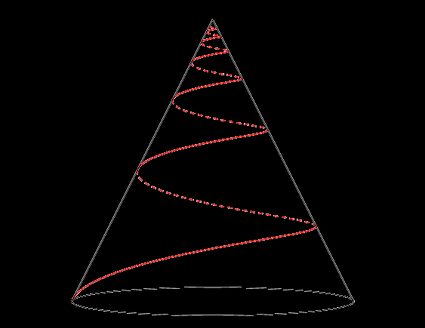
The conical helix gives us excellent uniformity when seen from the side or from the top. Not that many people look at Christmas trees from the top, but it's good to have all the bases covered. Moreover, it has almost rotational symmetry so that it does not matter where you start wrapping the tree or if you turn it around. With this in mind, the next step is to explore the mathematical equations that define such a shape. Those are not as complicated as one might think! Let's introduce them in the 3D coordinates :
where:
- — A parameter such that ;
- — The starting radius (which for us is the diameter at the base of the tree);
- — The height of the cone (tree); and
- — Tells us (indirectly) how many times the ribbon will rotate around the cone.
To calculate the length of the lights, we can use the following integral. This is probably the most complicated operation in the whole calculation because we need to take an integral of a square root:
With a very basic understanding of integration, you could solve it by hand. You don't need to do it, though, because we have created this easy calculator to do all the dirty work for you. If you still need the exact formula, here it is:
where is the natural logarithm. The above relations assume the Archimedean spiral in the base of the cone.
However, we did not limit the calculator to Dr. Troy Henderson's idea of modeling the tree lights. We also included extra functionality. The calculator can not only determine the length needed to cover the tree adequately but also the amount of Christmas baubles that you will need to use to decorate the tree. For this second calculation, there is no fancy math required. The calculator will first compute the surface area of the cone formed by the tree. With this value and your desired density of baubles, the calculator will obtain the necessary number of baubles as well as tell you what percentage of the surface of the tree will be covered by these bubbly Christmas decorations.
With this information you can now plan how many baubles you need to prepare and how long should your lights and ribbons be!
Putting up Christmas decorations early makes us happier!
And it is not just us making that up; experts have scientifically proven it! Christmas decorations and promotions in October or November in shops are already a standard that reminds many people of the commercialization of Christmas. However, it turns out that there is nothing wrong with the early celebration of the upcoming Christmas. In fact, according to scientists, it may even be beneficial for us if we start to hang up the decorations a few weeks before others.
In the , authors write that:
U.S. residents may use holiday decorations on their home's exterior to communicate friendliness and cohesiveness with neighbors
And the same thing applies to lights and ornaments on Christmas trees! Having the spirit of Christmas and the joy of its coming, already in November, may make people more friendly, accessible, and sociable. Scientists proved this by doing research on a group of people who were shown different homes. Some had Christmas decorations, and others didn't. The houses were of different sizes and represented different socio-economic backgrounds. Participants clearly indicated that decorated houses make their owners seem "friendly and coherent".
All of this proves that Christmas trees make their owners more sociable in the eyes of others. We think that Christmas has, indeed, some magic that makes people happier. And there is a scientific explanation for this. According to the psychoanalyst, :
In a world full of stress and anxiety, people like to associate with things that make them happy, and Christmas decorations evoke those strong feelings of childhood.
Christmas preparation shouldn't interfere with your education. Be sure to finish everything before this wonderful time to spend it all with your family. The grade calculator or test grade calculator might be handy tools if you need to check if you pass every course.
Mini Christmas tree history: the first Christmas tree
In a culture greatly influenced by Christian traditions, like the Western culture is, the thought of a Christmas tree makes some people uncomfortable. A Christmas tree is thought of by some as a pagan symbol that is opposed to their religious beliefs, but is it really a pagan symbol? Despite the popular thought that Christmas trees are specifically mentioned in the Bible as a form of heresy, it is very unlikely that Christmas trees existed at that time.
Even though evergreen branches have been used for longer than recorded history as a decoration, the first real Christmas tree seems to have appeared in 1510 in Riga. It was located in the main square of the Latvian capital as a Christmas decoration and burnt after the holidays. The first Christmas tree was not the start of a widespread tradition but something more anecdotal. History points towards Germany as the next important milestone in widespread Christmas tree adoption. Protestant founder Martin Luther used them as Christmas decorations.
From there, it seems like adoption started growing, as German settlers in Pennsylvania started using Christmas trees as decoration and candles as lights. Most of the concerns about pagan symbolism began to disappear as the royal family was drawn celebrating Christmas with a mini Christmas tree as decoration. Since that moment, the usage of Christmas trees and Christmas tree ornaments grew (apparently spreading from east to west) in the USA until it became one of the key symbols of Christmas.
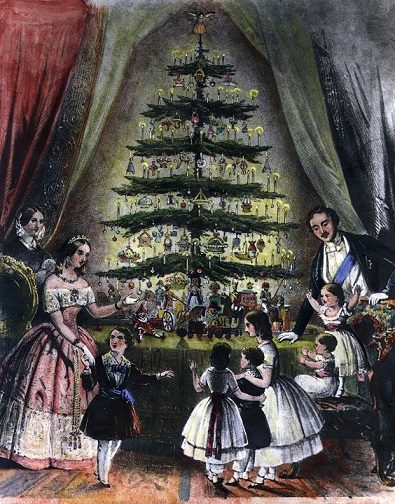
Still today, there are concerns about the (pagan) symbolism of a real Christmas tree, but most people embrace this tradition and have their Christmas tree at home. It is tough nowadays to imagine Christmas decorations without thinking of a Christmas tree with all its ornaments.
Choosing Christmas tree decorations: lights vs. ribbons
No person should ever be discriminated against for their color, shape, or looks... and neither should Christmas decorations! Moreover, it is not a calculator's job to pass judgment on what type of Christmas tree decorations are superior. That is why we built this Christmas tree calculator on purpose so that it would be "decoration-type agnostic". Some people prefer LED Christmas tree lights because they produce more light and create a holiday-like atmosphere in the room. Others, however, prefer the understated and discreet look of the ribbons.

So whether you are in love with lights or you adore ribbons, we have you covered. The calculator will provide you with a result, no matter what type of decoration you want to use. As long as you are wrapping the Christmas lights/ribbons in the conical helix shape we have discussed above, you will be fine, and our calculations will give you useful results.
Just remember: all Christmas decorations are equal and have their places. You should not judge people for choosing one over the other, just respect. Tolerance is the key to a good, healthy relationship, so if you see someone using ribbons instead of lights, just tell them that they are not alone, that you love them anyway, and that you will help them get their life back together ;)
You calculated everything, now what?
Now that you have figured out how many lights you need, you just need to consider the electricity cost to decide how long you want to keep them on. Alternatively, you can buy better, efficient LED Christmas tree lights, run them for longer, and save money.
Another option is to build your own set of lights. If you embark on such a DIY project, you can probably use some of our electrical calculators as a starting point. You can also relax and, e.g., play some games. We recommend building something ambitious in Minecraft with your friends (the minecraft circle generator could be a great help). If you're already a professional FPS player, check the eDPI calculator to find effective mouse sensitivity instead!
